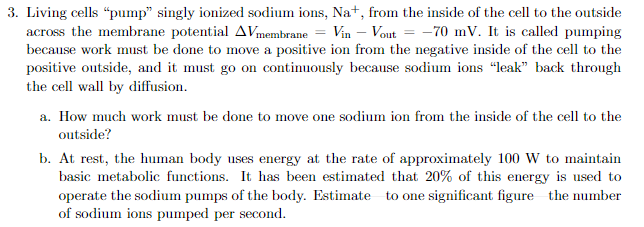3. Living cells "pump" singly ionized sodium ions, Na+, from the inside of the cell to the outside across the membrane potential AVmembrane Vin - Vout= -70 mV. It is called pumping because work must be done to move a positive ion from the negative inside of the cell to the positive outside, and it must go on continuously because sodium ions "leak" back through the cell wall by diffusion. a. How much work must be done to move one sodium ion from the inside of the cell to the outside? b. At rest, the human body uses energy at the rate of approximately 100 W to maintain basic metabolic functions. It has been estimated that 20% of this energy is used to operate the sodium pumps of the body. Estimate to one significant figure the number of sodium ions pumped per second.
3. Living cells "pump" singly ionized sodium ions, Na+, from the inside of the cell to the outside across the membrane potential AVmembrane Vin - Vout= -70 mV. It is called pumping because work must be done to move a positive ion from the negative inside of the cell to the positive outside, and it must go on continuously because sodium ions "leak" back through the cell wall by diffusion. a. How much work must be done to move one sodium ion from the inside of the cell to the outside? b. At rest, the human body uses energy at the rate of approximately 100 W to maintain basic metabolic functions. It has been estimated that 20% of this energy is used to operate the sodium pumps of the body. Estimate to one significant figure the number of sodium ions pumped per second.
Physics for Scientists and Engineers, Technology Update (No access codes included)
9th Edition
ISBN:9781305116399
Author:Raymond A. Serway, John W. Jewett
Publisher:Raymond A. Serway, John W. Jewett
Chapter27: Current And Resistance
Section: Chapter Questions
Problem 27.38P: A Van de Graaff generator (see Fig. 25.23) is operating so that the potential difference between the...
Related questions
Question

Transcribed Image Text:3. Living cells "pump" singly ionized sodium ions, Na+, from the inside of the cell to the outside
across the membrane potential AVmembrane = Vin - Vout= -70 mV. It is called pumping
because work must be done to move a positive ion from the negative inside of the cell to the
positive outside, and it must go on continuously because sodium ions "leak" back through
the cell wall by diffusion.
a. How much work must be done to move one sodium ion from the inside of the cell to the
outside?
b. At rest, the human body uses energy at the rate of approximately 100 W to maintain
basic metabolic functions. It has been estimated that 20% of this energy is used to
operate the sodium pumps of the body. Estimate to one significant figure the number
of sodium ions pumped per second.
Expert Solution
This question has been solved!
Explore an expertly crafted, step-by-step solution for a thorough understanding of key concepts.
This is a popular solution!
Trending now
This is a popular solution!
Step by step
Solved in 4 steps with 15 images

Knowledge Booster
Learn more about
Need a deep-dive on the concept behind this application? Look no further. Learn more about this topic, physics and related others by exploring similar questions and additional content below.Recommended textbooks for you

Physics for Scientists and Engineers, Technology …
Physics
ISBN:
9781305116399
Author:
Raymond A. Serway, John W. Jewett
Publisher:
Cengage Learning

Physics for Scientists and Engineers
Physics
ISBN:
9781337553278
Author:
Raymond A. Serway, John W. Jewett
Publisher:
Cengage Learning

Physics for Scientists and Engineers with Modern …
Physics
ISBN:
9781337553292
Author:
Raymond A. Serway, John W. Jewett
Publisher:
Cengage Learning

Physics for Scientists and Engineers, Technology …
Physics
ISBN:
9781305116399
Author:
Raymond A. Serway, John W. Jewett
Publisher:
Cengage Learning

Physics for Scientists and Engineers
Physics
ISBN:
9781337553278
Author:
Raymond A. Serway, John W. Jewett
Publisher:
Cengage Learning

Physics for Scientists and Engineers with Modern …
Physics
ISBN:
9781337553292
Author:
Raymond A. Serway, John W. Jewett
Publisher:
Cengage Learning


College Physics
Physics
ISBN:
9781938168000
Author:
Paul Peter Urone, Roger Hinrichs
Publisher:
OpenStax College

College Physics
Physics
ISBN:
9781285737027
Author:
Raymond A. Serway, Chris Vuille
Publisher:
Cengage Learning